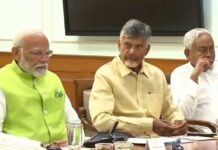Govt departments are currently discussing a 30-point action plan to achieve this target under Modi’s pet ‘Digital India’ scheme.
A trillion-dollar “digital economy” is a key target of the Narendra Modi government’s ‘Digital India’ mission. Now, various government departments are discussing a blueprint for getting there.
The document, accessed by ThePrint, is titled ‘India’s Trillion Dollar Digital Opportunity’. It outlines a 30-point implementation module for creating up to $1 trillion of digital revenue by 2022, and $1 trillion of economic value from the digital economy by 2025.
It is the result of a collaboration between the Ministry of Electronics and Information Technology (MEITY) and global management consultant McKinsey & Co, with the intent to “shape the vision and roadmap for a trillion dollar digital economy”.
IT minister Ravi Shankar Prasad has so far chaired two key meetings to discuss the blueprint – with the most recent one held only last week to discuss the blueprint. The last meeting was attended by Rajan Anandan of Google, Raman Roy, CEO of Quatrro, a global services company that offers business and knowledge processing services, Jio president Mathew Oommen, Hari Om Agarwal of Lava International, Ola co-founder Pranay Jivrajka, Harmeen Mehta of Airtel, and Shivnath Thukral of Facebook, among others.
The document presents a vision for how India’s digital economy can unlock productivity and value – through transformative infrastructure, applications and ecosystems. It also outlines iconic ‘Lighthouse Projects’ that will have an impact on India in the digital arena, and how best to accelerate their implementation.
The vision document identifies 30 ‘digital themes’ under nine sections which are key to empowering the country.
These nine sections deal with various steps needed to ensure quality education, healthcare and energy for all, besides generating jobs for the future, creating templates for the e-governance mechanism, and creating 21st century IT infrastructure and software capabilities.
The vision document lays down a template for ‘Make in India, Make for India and Make for the world’ – through end-to-end digital supply chains, digital platforms, and GPS installation for efficient transportation, and a boost to domestic electronics.
It envisions doubling farmer incomes through online agricultural marketplaces and precision agriculture. ‘Energy for all’ can be achieved through digitally enabled power distribution, and smart grids, it states. In addition, it also mentions an India Education Stack and a Virtual University policy, along with digital content delivery in schools.
The document further outlines four basic overarching principles which are prerequisites to building the new digital economy.
The need to radically improve ease of operations and reduce cost of operations for digital businesses. Citing the example of Ireland, the report calls for concrete, time-bound goals to enable entrepreneurs to set up businesses in less than a day. A clear definition of a digital business is essential to ensuring preferential treatment to them.
Unlocking the flow of domestic Indian capital into digital businesses.
Supporting Indian digital innovators through strategic procurement, where the government as a large buyer of services can act as a market-maker and create scale for best innovations through a tendering /procurement system that places greater value on digitally enabled vendors.
Unshackling of centres of higher education and innovation, to create a competitive advantage through a well-equipped workforce.
To launch the plan, it has been advised that within the next six to 12 months the government set up sector-specific consultative forums, beginning with five – on technology infrastructure, health care, education and skill training, agriculture and food processing, and transportation and logistics. Sector-specific national information utilities are envisaged for the five areas, like UIDAI and GSTN.
The other proposal is to immediately launch certain ‘Lighthouse Projects’, led by the private sector and supported by the government, to demonstrate impact in new areas within a year’s time.
Also, a digital dashboard is to be set up to measure progress on existing as well as future initiatives. #KhabarLive







